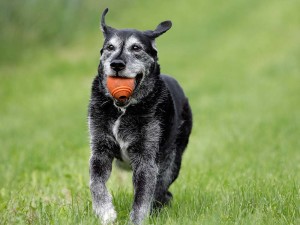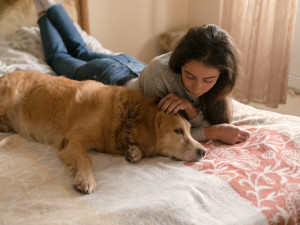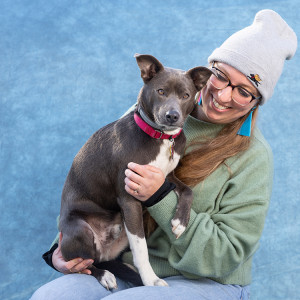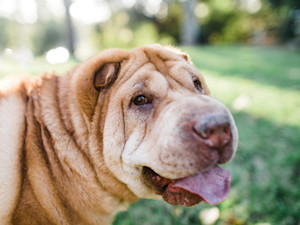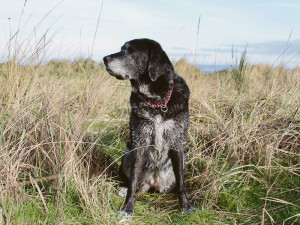Canine Dementia: Causes, Signs and Treatment
Learn about the signs, symptoms, and treatments.
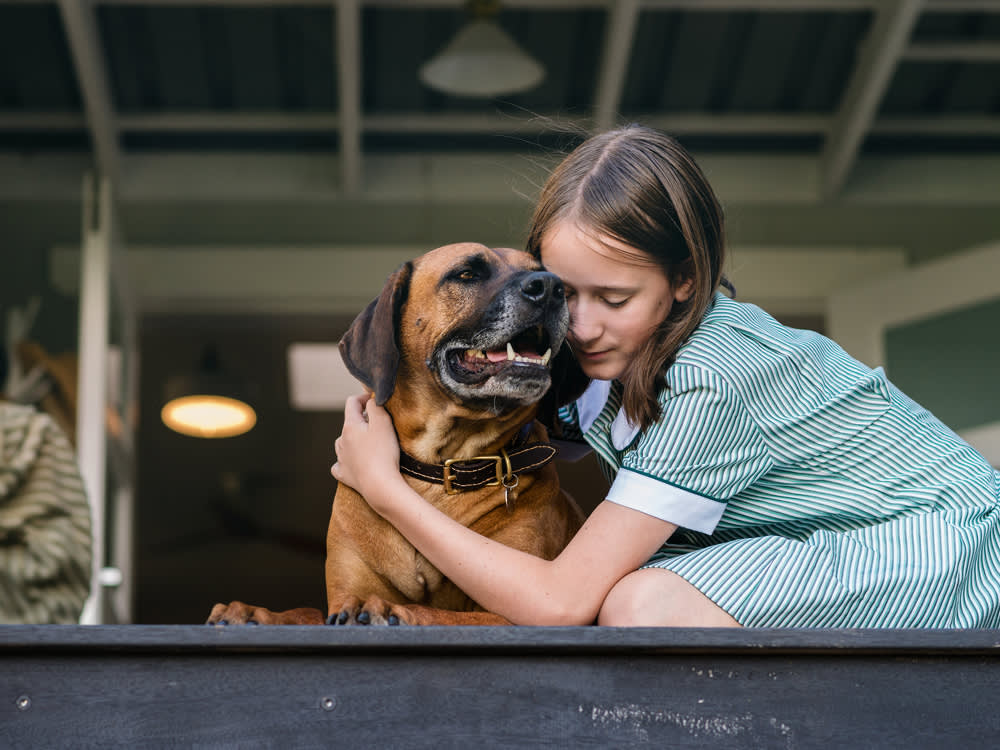
share article

Your pet wants you to read our newsletter. (Then give them a treat.)
In this Article:
What Is Dog Dementia?opens in a new tab Types Of Dog Dementiaopens in a new tab Causes Of Dog Dementia opens in a new tabSigns Of Dog Dementiaopens in a new tab How Is Dog Dementia Diagnosed?opens in a new tab
Our dog Mic’s symptoms were so subtle and their onset so gradual that we didn’t initially see them. In fact, our other dogs noticed them first. Mic, a Pembroke Welsh Corgi who was 12 at the time, had always embodied good dog manners. He’d never met a dog who didn’t like him. But suddenly, he was enraging our other dogs. We sympathized: His nighttime barking was fraying our nerves, too.
A number of vet visits and lab tests revealed nothing, but Mic continued to decline. When his spatial perception deteriorated, we realized that he was acting like some elderly people we had known, and concluded, almost tongue-in-cheek, that he was senile with “doggie dementia.”
But can dogs have dementia? Turns out, they certainly can. Although many veterinarians and dog parents are unaware of it, canine cognitive dysfunctionopens in a new tab, or CCD (also known as cognitive dysfunction syndrome), affects a significant portion of the senior dog populationopens in a new tab. The advances in veterinary medicine and improved pet parent care that have helped dogs live longer have also increased the incidence of CCD — but as many as 85 percent of cases may go undiagnosed.
“It’s a big issue, and there’s not much awareness of it, even among vets,” says Dr. Leticia Fanucchi, PhD, a veterinary behaviorist and director of Veterinary Medicine Behavioral Services at Washington State University’s Veterinary Teaching Hospital. “I get that question — ‘Do dogs get dementia?’ — even from colleagues.” But canine dementia is nothing new.
“I first started recognizing symptoms of what we now refer to as ‘cognitive dysfunction’ in dogs over 30 years ago,” says Dr. Dennis Thomas, a holistic practitioner in Spokane, Washington and author of Whole-Pet Healing: A Heart-to-Heart Guide to Connecting with and Caring for Your Animal Companionopens in a new tab. “We didn’t have a catchy term for the disease, so I called it ‘pre-senility syndrome.’”
What is dog dementia?
Dog dementia, or CCD, an umbrella term for four separate cognitive forms, is an age-related neurobehavioral syndrome in senior dogsopens in a new tab leading to a decline in cognitive function that can be devastating. This condition, also referred to as cognitive dysfunction syndrome (CDS), affects older dogsopens in a new tab, and the odds of a dog having CDS increase 52 percent opens in a new tabwith each additional year of age. CCD progresses gradually, often starting with only one or two obvious signs before the dog demonstrates more obvious indicators.
What are the different types of canine dementia?
There are several different types of dog dementiaopens in a new tab, and the condition shows itself in different ways depending on the dog and the type of CCD.
Involutive depression
This is depression that occurs in the dog’s later years, similar to chronic depressionopens in a new tab in humans. Several factors may be involved, but untreated anxieties seem to play a key role. Because some of the symptoms of canine dementia — circling, wandering, and house soiling — often result in the dog’s confinement, anxiety can increase, which, in turn, worsens the symptoms. Other symptoms of this form of CCD include lethargy, sleep disorders, decreased learning, and vocalizing.
Dysthymia
This often involves loss of awareness of body length and size. “Dogs with dysthymia often get stuck,” Fanucchi explains. “Behind furniture, in a corner. All they have to do is walk backwards, but they don’t know that.” Other symptoms include disrupted sleep-wake cycles; constant growling, whining, or moaning; and aggressive behavior. “If you interrupt a dog while they’re in a dysthymic state, they can get mad and bite,” Fanucchi cautions. Causes of this form are thought to include hyperadrenocorticism (such as Cushing’s diseaseopens in a new tab) and long-term steroid therapy.
Hyper-aggression
In old dogs, hyper-aggression is associated with the dysfunction of structures related to the neurotransmitter serotonin. Cortical tumors may also be involved. “Dogs with this form of CCD lose their ability to communicate with other animals,” Fanucchi explains. “They neither give appeasing signals to other pets in the house nor understand when others send them. They bite first and warn second.”
Confusional syndrome
This involves a profound decline in cognitive ability. According to Fanucchi, it is the closest thing to Alzheimer’s in humans. “They just don’t seem to learn well in any form anymore. They forget familiar features of their lives, including other pets and people. When it’s more advanced, they forget who their human parents are.”
What causes dog dementia?
As with human dementia or Alzheimer’s diseaseopens in a new tab, the causes of dog dementia are not well known, but accumulations of sticky proteins called beta-amyloid plaques around neurons and the breakdown of neurons resulting in so-called neurofibrillary tangles are considered to be the leading culprits. As in humans, both phenomena affect the brain by interrupting nerve impulse transmission. These changes are linked to aging because, as a dog ages, the brain atrophies, causing the death of some cells. Dog dementia impacts the areas of the brain responsible for learning, memory, and coordination.
What are the signs of dog dementia?
When we recognized the possibility of dementia in Mic, we began researching and quickly discovered Eileen Anderson, whose book Remember Me?opens in a new taband websiteopens in a new tab are invaluable CCD resources. Among Anderson’s many helpful tools is a symptom checklist, which includes the following dog dementia signs:
Pacing back and forth or in circles (often turning consistently in one direction)
Getting lost in familiar places
Staring into space or at walls
Walking into corners or other tight spaces and staying there
Appearing lost or confused
Waiting at the “hinge” side of the door to go out
Failing to get out of the way when someone opens a door
Failing to remember routines, or starting them and getting only part way through
Sundowning
Anderson’s list comes with a warning. “The most important thing to understand is that any apparent CCD symptom could also point to a serious, and perhaps treatable, medical condition,” she stresses. The first stop, she says, is the vet.
When standard tests reveal no medical cause for dementia symptoms, it’s time to consider CCD. While dog parents may find that — given the veterinary community’s limited awareness of the condition — they’re initially on their own, some practitioners are better versed in its treatment. Veterinary behaviorists and holistic veterinarians are particularly good options.
Although ongoing research offers hope for a cure, dog dementia is not currently considered reversible. Certain forms of CCD may be preventable, however, and for others, the symptoms can be minimized. As with humans, lifelong holistic care is key. At some point in every dog’s life, routine preventive care must be fine-tuned with the specific aim of offsetting a dog’s potential for developing CCD. This involves the addition of anti-aging factors through diet and supplements. Fanucchi says that timing varies depending upon size, as larger dogs tend to live shorter lives. “Begin giant breeds at age five, small breeds at 10, others in between,” he says.
How is canine dementia diagnosed?
Because the symptoms of CCD can indicate a number of other conditions and illnesses, from vestibular diseaseopens in a new tab to degenerative myelopathyopens in a new tab, diagnosing dog dementia is a process of elimination. Your veterinarian will rule out all other potential medical issues before diagnosing your dog with CCD.
While there is no specific dog dementia assessment, your veterinarian will run a number of tests, including a physical examination, routine blood tests, thyroid testing, ultrasounds, and X-rays to rule out other illnesses. They may also recommend more advanced imaging, such as a CT scan or MRI.
It’s important to take your dog to the veterinarian as soon as you notice any of the potential symptoms of CCD. The earlier your dog is diagnosedopens in a new tab, the better you can manage their symptoms of canine dementia.
How is dog dementia treated?
According to Fanucchi, dementia treatment for dogs involves management of behavior and environment, enhanced diet, and medication. The dual goals of treatment are slowing the disease’s progress and improving quality of life for dogs and their people.
“Behavior can be effectively managed by providing daytime activities and opportunities for play, as well as structured social interaction for physical and mental stimulation,” Fanucchi says. “Exposure to sunlight will help regulate the sleep-wake cycle. If they can’t walk anymore, use a wagon or a strolleropens in a new tab. Managing the environment is also very important. Make it more predictable. Pet-proof the houseopens in a new tab just as you’d toddler-proof it.” Providing adequate toileting opportunities is essential as well, as old dogs can’t “hold it” as they did when they were younger; diapers, pads, and waterproof bed and furniture covers may be helpful.
Managing dementia with nutrition
Nutrition options fall into two categories: Commercial and natural or home-prepared whole foods. Commercial foods focus on the addition of antioxidants for cellular-level health and to reduce oxidative stress on the brain, and medium-chain triglycerides for cognitive improvement. Only a few commercial pet food manufacturers offer prescription senior dog food.
Dr. Thomas acknowledges commercial foods’ benefits but advises a different course. “I don’t recommend heat-processed food for dogs,” he says. “I recommend feeding a balanced, wholesome, natural diet with the same beneficial supplements added.”
Supplements for dog dementia
For dog dementia, supplements can help reduce the severity of symptoms. The pharmacological approach to CCD treatment also focuses on control of oxidation and enhancement of brain function. The antioxidant supplement SAMe (S-adenosylmethionine) has proven effective in both staving off CCD and moderating its symptoms. Antioxidant nutritional supplements such as Denamarin, silybin, vitamin E, Cholodin, and omega-3 fatty acidsopens in a new tab can be added to any diet, as can Solliquin, which contains an amino acid that can reduce CCD-related anxiety. Talk to your vet before adding supplements to your dog’s diet.
Pharmacological treatment options for dog dementia
Like many medical conditions, when it comes to dog dementia, medication is a strong treatment option. The drug primarily used to treat CCD by improving brain function is selegiline (Anipryl). A monoamine oxidase inhibitor (MAOI), it’s thought to improve brain chemistry by reducing the breakdown of dopamine and other neurotransmitters. Another drug, propentofylline, helps with the circulation of blood in the brain. Some dogs with CCD also benefit from anti-anxiety medicationsopens in a new tab if they have anxiety-related symptoms.
Alternative therapies for dog dementia
Alternative therapies offer a complement to conventional CCD treatments. For example, traditional Chinese medicine is thought to operate consistent with quantum physics, on the molecular and atomic levels, by addressing energy imbalances. “I encourage looking for alternative forms of treatment, as well as the conventional,” Thomas says. “I prefer to treat this disease with acupuncture and Chinese herbs, supplements, diet modification, and energy medicine.”
Can dog dementia be prevented?
Because veterinarians aren’t certain what causes CCD in dogs, it can be hard to determine the best ways to prevent it. However, there are several things pet parents can do to help keep their dogs physically and mentally active, which can serve as preventive measures of dog dementia.
Teach your dog new tricks.
Play games with your dog.
Feed them a nutritionally balanced diet.
Go for regular walksopens in a new tab.
Eliminate potential exposure to toxins.
Avoid situations that may be stressful to your dog.
Dog dementia and end of life
Sadly, dog dementia will eventually force a very tough decision. “When dogs’ bodily functions become so impaired that they lose quality of life, that’s when the hard call is made,” Fanucchi says. “It’s just a matter of time until they deteriorate to the point that other systems fail. You don’t want to see your pet in this state — it’s very hard.”
Thomas agrees. “That is the toughest thing a dog caretaker has to address. It usually comes down to what the caretaker defines as ‘quality of life.’ Veterinarians can often help because they are not emotionally involved and can explain how the situation is affecting everyone.”
Making this decision can be especially hard when the animal is otherwise healthy. “It can be extremely difficult to consider euthanasia for a dog who is at a healthy weight, not necessarily in pain, and occasionally coherent,” Eileen Anderson says. She points to a tool that can help: the Villalobos Quality of Life Scaleopens in a new tab. Designed by veterinarian Dr. Alice Villalobos, it offers an objective means of inventorying quality-of-life details. “Even those hesitant to do the numbers will benefit from the Villalobos scale, considering its unbiased presentation of the facts,” Anderson says.
Research on dog dementia offers hope
Alzheimer’s has never been reversed in human beings, but it may have been in two Australian dogs. Recently, a team of veterinary and human medical researchers at the University of Sydney Brain and Mind Centre appear to have restored cognition in these CCD-suffering dogs using the animals’ own stem cellsopens in a new tab.
The procedure involved growing neural cells from skin cells and inserting them into the dogs’ brains. The dogs have been rated as CCD-free based on independent application of the University of Sydney-developed CCD Rating Scale, and their caretakers report a significant return of the animals’ original personalities.
While at a very early stage and with a minuscule sample, the process appears to offer hope for humans as well as dogs. Although human and canine brains are different, their similarities are striking, with dementia symptoms and their practical impact and response to treatment being almost identical in both.
“The procedure is not to be undertaken lightly since it involves anesthetizing the dog twice and, well, brain surgery,” Anderson points out. “The good news is that two dogs with dementia have successfully undergone the procedure. This fascinating research offers some hope.”
Judging by Mic, the approaches described here can work. A natural diet augmented with SAMe and other supplements improved his cognition. Thanks largely to acupuncture and Chinese herbs, his formerly debilitating physical deficits were controlled. Treatment eliminated his nighttime barking and, under supervision, his dog siblings tolerated him. He lived nearly two mostly happy and relaxed years after the onset of CCD. Had Mic’s symptoms not improved, we would simply have followed Eileen Anderson’s golden rule: “All that matters is to love the dog in front of you.”
FAQs (People also ask):
When is it time to consider euthanasia for a dog with dementia?
Considering euthanasia for your dog is a difficult decision, and the right time is different for every pet and family. For dogs with CCD, it’s important to consider your dog’s quality of life and how their symptoms impact their day-to-day life. Your vet can help you make this decision based on your pet’s symptoms of dog dementia, quality of life, and any pain they may be in.
Is there support for caregivers of dogs with dementia?
There are support groups for pet parents of dogs with dementia. You can search online or ask your veterinarian about local groups in your area or check out online groups on Facebook and other social media platforms.
Are there certain breeds that are more prone to dementia?
According to researchopens in a new tab, you may more frequently see dog dementia in breeds like Terriers, toy breeds, and non-sporting breeds, which are as much as three times more likely to be diagnosed with CCD compared to other breeds. However, dog dementia can impact any breed.
What is the life expectancy for a dog that has been diagnosed with dementia?
There is no specific timeframe for how long a dog can live with CCD. If your dog has no other health conditions, then it’s a matter of how significantly dog dementia affects their quality of life. Work with your veterinarian to track your dog’s reduced quality of life, and determine the best time to say goodbye.
References:
Michael and Susan Cain, ARNP
Sue Cain is a nurse practitioner who spends her free time with her Pembroke pack, practicing and competing in agility. Mike is a freelance writer.
Related articles
![Happy golden retriever dog on a walk with owner in woodsy yellow and orange fall setting with leaves on the dirt trail.]() opens in a new tab
opens in a new tabHome Remedies for Dog Joint Pain Relief
DIY ways to help your pup cope with the pain.
![brown puppy eating food out of green bowl]() opens in a new tab
opens in a new tabA Digestible Guide to Healthy Dog Food
How to pick the right grub for your pup when there are So. Many. Choices.
![Shar pei]() opens in a new tab
opens in a new tabLipomas in Dogs: Causes, Symptoms and Treatment of Fatty Tumors
Here’s why you (probably) shouldn’t worry.
![Cheerful Brunette Having Fun With Her Dog Outside]() opens in a new tab
opens in a new tabBig Fish: The Best Omega-3 Supplements for Dogs (And Why They Need Them)
Fatty acids rev up your dog’s energy, keep their coat shiny, help with inflammation from allergies and arthritis, and so much more.
![Portrait Of Large, Senior, Mixed Breed Dog On Beach]() opens in a new tab
opens in a new tab10 Tips for Grieving a Pet
For National Pet Memorial Day — Sept. 12th — we asked 5 grief experts how to cope with feelings of guilt after we lose a pet.
![]() opens in a new tab
opens in a new tab13 Products Your Senior Dog Needs
From doggy diapers to toe grips, this gear will help your pet thrive through their golden years.

